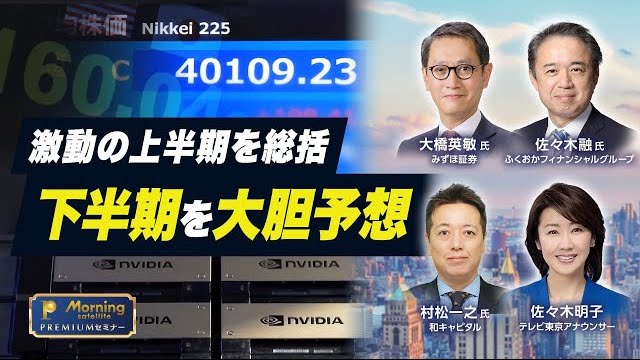TOKYO, Jul 04 (News On Japan) - In the first half of this year, the market experienced significant fluctuations, marking a historic turning point for the Japanese market. The Nikkei Stock Average surpassed 40,000 yen for the first time in March. Meanwhile, despite the high-interest-rate environment in the United States, the economy remained robust, and stock prices continued to hit record highs.

In the foreign exchange market, the yen depreciated to its lowest level in 34 years, surpassing 160 yen per dollar in April. Following a turbulent first half, where is the market headed in the second half? At the MoSaTe Premium Seminar in June, experts in stocks, foreign exchange, and bonds reviewed the first half and made bold predictions for the second half, considering factors such as inflation, financial policies, and the U.S. presidential election.
Good evening, everyone. Thank you for participating in the MoSaTe Premium Seminar. I'm Akiko Sasa from TV Tokyo. It's been a while since I last hosted a seminar, and given the current volatile market conditions, I feel a great sense of responsibility. I hope you all enjoy and gain insights into the current market trends. Let's take a moment to reflect on the first half of the market, which saw the yen briefly surpass 160 yen per dollar in April. Although the dollar-yen rate later declined, it has been on an upward trend again since the Bank of Japan's decision on June 14, currently hovering around 159.50 yen per dollar, after briefly reaching near 159.90 yen today.
In May, Japan's long-term interest rates exceeded 1% for the first time in 11 years. The Nikkei Stock Average also broke the 40,000-yen mark for the first time in March. Similarly, global stock markets, including the U.S., have been hitting record highs. Given such a tumultuous first half, what can we expect in the second half? In this seminar, experts in stocks, foreign exchange, and bonds will review the first half of the market and make bold predictions for the second half.
Let's introduce our speakers. First, we have Hidetoshi Ohashi from Mizuho Securities, an expert in bonds and credit. Next, Tohru Sasaki from Fukuoka Financial Group, a specialist in foreign exchange. Finally, we have Kayu Muramatsu from Nami Capital, a specialist in stocks. It's the first time these three experts have come together. Although it's rare to have three specialists in the same studio, let's make the most of this opportunity.
Let's review the seminar schedule. The first part will discuss the unexpected market trends in the first half, analyzing the background of these trends to prepare for the second half. The second part will outline market scenarios for the second half, considering various factors like financial policies in Japan and the U.S., the U.S. presidential election, and political developments in Japan. The third part will focus on investment strategies from the second half to the next year, with experts providing insights on investment tips. Finally, we will address your questions as time permits.
This first half has seen significant market movements. In the first part, our guests will discuss what they found unexpected in their respective fields and analyze the background of these surprises. Let's take a look at their unexpected findings.
Ohashi noted the significant rise in Japan's long-term interest rates, exceeding 1%. Sasaki pointed out the unexpectedly rapid rise of the dollar-yen exchange rate, reaching the year-end target of 160 yen by April. Muramatsu highlighted the sharp rise in Japanese stocks, breaking historical records early in the year. These swift and significant movements in various markets have taken many by surprise.
For Muramatsu, the unexpected development was the rapid and significant rise in Japanese stocks, reaching 40,000 yen in March. Reviewing the movements from February to March, the Nikkei Stock Average surged past historical highs, eventually reaching 41,087 yen on March 22. Muramatsu attributes this to a thin market environment, where short sellers were squeezed, leading to a sharp rise. He also noted that this rise was faster than anticipated, driven by a combination of factors, including domestic and global economic conditions.
Sasaki mentioned that the yen's rapid depreciation to 160 yen per dollar by April was unexpected. He had initially forecasted this level for the year-end. Sasaki attributed this to several factors, including the market's reassessment of the U.S. interest rate outlook and the yen's inherent weakness. He also highlighted the structural issues facing the yen, such as Japan's negative real interest rates and deteriorating current account balance.
Lastly, Ohashi discussed the unexpected rise in Japan's long-term interest rates, surpassing 1% in May. He noted that while he had anticipated a rise, the pace was faster than expected. This rapid increase was driven by market expectations of a shift in the Bank of Japan's policy stance, which became evident following a meeting between Prime Minister Kishida and Bank of Japan Governor Ueda.
Given these unexpected developments in the first half, what can we expect in the second half? With upcoming events like the U.S. presidential election and potential changes in financial policies, the market is poised for further volatility.
Source: テレ東BIZ















